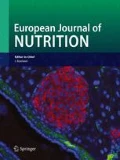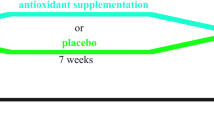Abstract
Purpose
Açai pulp is a source of phytochemicals and has been associated with antioxidant, anti-inflammatory, and antigenotoxic effects. This study aimed to assess the effects of açai pulp consumption on oxidative, inflammatory, and aerobic capacity markers of cyclist athletes.
Research methods and procedures
A crossover, randomized, placebo-controlled, single-blind study was developed with ten male cyclists (33.5 ± 4.7 years old, body mass index of 23.9 ± 1.38 kg/m2, and training load around 1875 ± 238 AU/week). The athletes consumed 400 g/day of pasteurized açai pulp (AP) or placebo (PL) for 15 days, with a 30-day wash-out period between trials. Lipid peroxidation, serum antioxidant capacity, DNA damage in peripheral blood (Comet assay), IL-6 and TNF-alpha, blood lactate concentration during effort, anaerobic threshold intensity (ATi), maximum workload reached (Wmax), rating of perceived exertion threshold (RPET), and heart rate threshold (HRT) were evaluated before and after each intervention. Data were analyzed using a linear regression model with mixed effects (p ≤ 0.05).
Results
Increased serum antioxidant capacity (p = 0.006) and decreased lipid peroxidation (p = 0.01) were observed in subjects after intervention with AP. Blood lactate levels during effort significantly decreased (by 29%, p = 0.025) and ATi increased (p = 0.006) after AP. No significant effect on DNA damage was attributed to AP consumption.
Conclusion
We found notable effects of AP intervention on antioxidant status in athletes. Both the reduction in blood lactate concentration and increase in ATi during the effort suggest an overall improvement in the aerobic capacity of the cyclists, confirming that AP consumption may influence variables associated with performance in endurance athletes.





Similar content being viewed by others
References
Sabbe S, Verbeke W, Deliza R, Matta VM, Van Damme P (2009) Consumer liking of fruit juices with different açai (Euterpe oleracea Mart.) concentrations. J Food Sci 74:S171–S176
Schreckinger ME, Lotton J, Lila MA, de Mejia EG (2010) Berries from South America: a comprehensive review on chemistry, health potential, and commercialization. J Med Food 13:233–246
Del Pozo-Insfran D, Brenes CH, Talcott ST (2004) Phytochemical composition and pigment stability of acai (Euterpe oleracea Mart.). J Agric Food Chem 52:1539–1545
Yamaguchi KK, Pereira LF, Lamarao CV, Lima ES, Da Veiga-Junior VF (2015) Amazon açai: chemistry and biological activities: a review. Food Chem 179:137–151
Elkington LJ, Gleeson M, Pyne DB, Callister R, Wood LG (2015) Inflammation and immune function: can antioxidants help the endurance athlete? In: Lamprecht M (ed) Antioxidants in sport nutrition. CRC Press/Taylor & Francis, Boca Raton
Tomasello B, Grasso S, Malfa G, Stella S, Favetta M, Renis M (2012) Double-face activity of resveratrol in voluntary runners: assessment of DNA damage by comet assay. J Med Food 15:441–447
Bowtell JL, Sumners DP, Dyer A, Fox P, Mileva KN (2010) Montgomery cherry juice reduces muscle damage caused by intensive strength exercise. Med Sci Sports Exerc 43:1544–1551
Davis JM, Carlstedt CJ, Chen S, Carmichael MD, Murphy EA (2010) The dietary flavonoid quercetin increases VO2 max and endurance capapcity. Int J Sport Nutr Exerc Metab 20:56–62
Sadowska-Krępa E, Kłapcińska B, Podgórski T, Szade B, Tyl K, Hadzik A (2015) Effects of supplementation with acai (Euterpe oleracea Mart.) berry-based juice blend on the blood antioxidant defence capacity and lipid profile in junior hurdlers. A pilot study. Biol Sport 32:161–168
Carvalho-Peixoto J, Moura MR, Cunha FA, Lollo PC, Monteiro WD, Carvalho LM et al (2015) Consumption of açai (Euterpe oleracea Mart.) functional beverage reduces muscle stress and improves effort tolerance in elite athletes: a randomized controlled intervention study. Appl Physiol Nutr Metab 40:725–733
Del Bo′ C, Riso P, Campolob J, Møller P, Loft S, Klimis-Zacas D et al (2013) A single portion of blueberry (Vaccinium corymbosum L) improves protection against DNA damage but not vascular function in healthy male volunteers. Nutr Res 33:220–227
Pontes J, Pfrimer K, Tremeschin MH, Molina MC, Chiarello PG (2010) Nutrição e Metabolismo. CONSUMO ALIMENTAR. Visualizando Porções. Guanabara Koogan, Rio de Janeiro
Núcleo de Estudos e Pesquisas em Alimentação, Universidade Estadual de Campinas (NEPA-UNICAMP). Tabela brasileira de composição de alimentos: TACO. 4 ed. Campinas: NEPA-UNICAMP; 2011
Foster C (2001) A new approach to monitoring exercise training. J Strength Cond Res 15:109–115
Foster C (1996) Athletic performance in relation to training load. Wis Med J 95:370–374
Borg GA (1982) Psychophysical bases of perceived exertion. Med Sci Sports Exerc 14:377–381
Campos EZ, Milioni F, Zanuto EAC, Almeida PB, Gobbi RB, Andrade VL et al (2013) Efeito das cargas de treinamento sobre parâmetros fisiológicos de futebolistas. Motriz 19:487–493
Kuipers H, Verstappen FT, Keizer HA, Geurten P, van Kranenburg G (1985) Variability of aerobic performance in the laboratory and its physiologic correlates. Int J Sports Med 6:197–201
Borges PRS, Tavares EG, Guimarães IC, Rocha RP, Araujo ABS, Nunes EE et al (2016) Obtaining a protocol for extraction of phenolics from açaí fruit pulp through Plackett-Burman design and response surface methodology. Food Chem 210:189–199
Apak R, Güçlü K, Özyürek M, Çelik SE (2008) Mechanism of antioxidant capacity assays and the CUPRAC (cupric ion reducing antioxidant capacity) assay. Microchim Acta 160:413–419
Yagi K (1998) Simple assay for the level of total lipid peroxides in serum or plasma. Methods Mol Biol 108:101–106
Janaszewska A, Bartosz G (2002) Assay of total antioxidant capacity: comparison of four methods as applied to human blood plasma. Scand J Clin Lab Invest 62:231–236
Tice RR, Agurell E, Anderson D, Burlinson B, Hartmann A, Kobayashi H et al (2000) Single cell gel/comet assay: guidelines for in vitro and in vivo genetic toxicology testing. Environ Mol Mutagen 35:206–221
Cohen B (2008) Explaining psychological statistics, 3rd edn. John Wiley & Sons, New York
Institute of Medicine (IOM) (2006) Dietary reference intakes: the essential guide to nutrient requirements, http://www.nap.edu/catalog/11537.html/
Pala D, Barbosa PO, Silva CT, de Souza MO, Freitas FR, Volp AC, Maranhão RC, Freitas RN (2017) Açai (Euterpe oleracea Mart.) dietary intake affects plasma lipids, apolipoproteins, cholesteryl ester transfer to high-density lipoprotein and redox metabolism: a prospective study in women. Clin Nutr 37:618–623
Barbosa PO, Pala D, Silva CT, Souza MO, Amaral JF, Vieira RAL et al (2016) Açai (Euterpe oleracea Mart.) pulp dietary intake improves cellular antioxidant enzymes and biomarkers of serum in healthy women. Nutrition 32:674–680
Santos HO (2019) Effect of Açaí (Euterpe oleracea) intake on vascular function and lipid profile: what is the recommendation? Int J Cardiovasc Sci 32:190–192
Schauss AG, Wu X, Prior RL, Ou B, Patel D, Huang D, Kababick JP (2006) Phytochemical and nutrient composition of the freeze-dried Amazonian palm Berry, Euterpe oleracea Mart. (Acai). Agric Food Chem 54:8598–8603
Gammone MA, Riccion IG, Gaspare P, D’Orazio N (2019) Omega-3 polyunsaturated fatty acids: benefits and endpoints in sport. Nutrients 11(1):46
Black KE, Witard OC, Baker D, Healey P, Lewis V, Tavares F et al (2018) Adding omega-3 fatty acids to a protein-based supplement during pre-season training results in reduced muscle soreness and the better maintenance of explosive power in professional Rugby Union players. Eur J Sport Sci 18:1–11
Esquius L, Garcia-Retortillo S, Balagué N, Hristovski R, Javierre C (2019) Physiological- and performance-related effects of acute olive oil supplementation at moderate exercise intensity. J Int Soc Sports Nutr 16:12
Edirisinghe I, Banaszewski K, Cappozzo J, Sandhya K, Ellis CL, Tadapaneni R et al (2011) Strawberry anthocyanin and its association with postprandial inflammation and insulin. Br J Nutr 106:913–922
Puglisi MJ, Vaishnav U, Shrestha S, Torres-Gonzalez M, Wood RJ, Volek JS et al (2008) Raisins and additional walking have distinct effects on plasma lipids and inflammatory cytokines. Lipids Health Dis 7:1–9
Spormann MT, Albert FW, Rath T, Dietrich H, Will F, Stockis JP et al (2008) Anthocyanin/polyphenolic–rich fruit juice reduces oxidative cell damage in an intervention study with patients on hemodialysis. Cancer Epidemiol Biomark Prev 17:3372–3380
Hoelzl C, Knasmuller S, Misik M, Collins A, Dusinska M, Nersesyan A (2009) Use of single cell gel electrophoresis assays for the detection of DNA-protective effects of dietary factors in humans: recent results and trends. Mutat Res 681:68–79
Staruchova M, Collins AR, Volkovova K, Mislanova C, Kovacikova Z, Tulinska J et al (2008) Occupational exposure to mineral fibres., biomarkers of oxidative damage and antioxidant defence and associations with DNA damage and repair. Mutagenesis 23:249–260
Xiao Dan, Wang Haiyan, Han Daxiong (2016) Single and combined genotoxicity effects of six pollutants on THP-1cells. Food and Chem Toxicol 95:96–102
Chequer FMD, Venâncio VP, Bianchi MLP, Antunes LMG (2012) Genotoxic and mutagenic effects of erythrosine B, a xanthene food dye, on HepG2 cells. Food Chem Toxicol 50:3447–3451
Lagouge M, Argmann C, Gerhart-Hines Z, Meziane H, Lerin C, Daussin F et al (2006) Resveratrol improves mitochondrial function and protects against metabolic disease by activating SIRT1 and PGC-1α. Cell 127:1109–1122
You Y, Yuan X, Lee HJ, Huang W, Jin W, Zhan J (2015) Mulberry and mulberry wine extract increase the number of mitochondria during brown adipogenesis. Food Funct 6:401–408
Mankowski RT, Anton SD, Buford TW, Leeuwenburgh C (2015) Dietary antioxidants as modifiers of physiologic adaptations to exercise. Med Sci Sports Exerc 47:1857–1868
Nieman DC, Henson DA, McAnulty SR, McAnulty LS, Morrow JD, Ahmed A, Heward CB (2004) Vitamin E and immunity after the Kona Triathlon World Championship. Med Sci Sports Exerc 36:1328–1335
Atalay M, Lappalainen J, Sen CK (2006) Dietary anti-oxidants for the athlete. Curr Sports Med Rep 5:182–186
Fernandes I, Freitas V, Mateus N (2014) Anthocyanins and human health: how gastric absorption may influence acute human physiology. Nutr Aging 2:1–14
Acknowledgements
The authors would like to thank the cyclists for participating in this study, company Petruz Fruity Group for granting pasteurized açaí pulp to this research, M.S. Ana Rita T. Machado for capturing the DNA damage picture, Dr. Thais B. César and Dr. Ana Lucia M. Nasser for expert assistance in oxidative stress assays, and Dr. Danielle R. Gonçalves and Dr. Paulo I. Costa for expert assistance in inflammatory assays. This study was financed in part by the Coordenação de Aperfeiçoamento de Pessoal de Nível Superior, Brasil (CAPES), Finance Code 001.
Author information
Authors and Affiliations
Corresponding author
Ethics declarations
Conflict of interest
The authors declare that there is no conflict of interest.
Rights and permissions
About this article
Cite this article
Terrazas, S.I.B.M., Galan, B.S.M., De Carvalho, F.G. et al. Açai pulp supplementation as a nutritional strategy to prevent oxidative damage, improve oxidative status, and modulate blood lactate of male cyclists. Eur J Nutr 59, 2985–2995 (2020). https://doi.org/10.1007/s00394-019-02138-7
Received:
Accepted:
Published:
Issue Date:
DOI: https://doi.org/10.1007/s00394-019-02138-7




